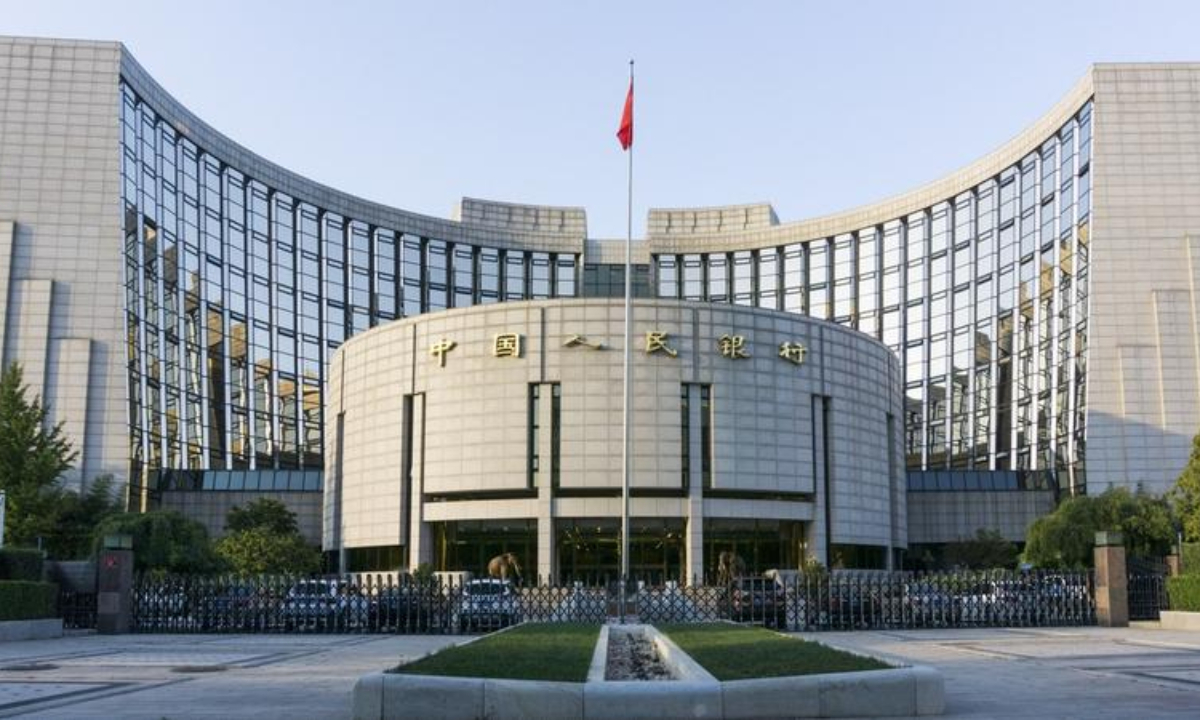
The headquarters of the People's Bank of China in Beijing Photo: IC
The People's Bank of China (PBC), the country's central bank, continued to inject funds into the financial system through open market operations on Tuesday. Such a move, by way of the short-term bond instrument, is likely to spur rate cuts for the medium-term lending facility (MLF) and benchmark lending loan prime rate (LPR), which are set to be announced soon, analysts said.
A flurry of possible stimulus measures could be anticipated in the near future as the government is resolved to stabilize market expectations about an economic rebound that has met with some downward pressure, as reflected by various indicators in April, they noted.
The PBC cut its seven-day reverse repo rate by 10 basis points to 1.90 percent on Tuesday, releasing 2 billion yuan ($279.97 million), the first time in 10 months.
A reverse repo is a process by which a central bank purchases securities from commercial banks through bidding, with an agreement to sell them back in the future.
The move is aimed at keeping liquidity reasonable and ample in the banking system, according to the central bank.
Based on experience, the seven-day reverse repo rate cuts will be followed by similar reductions to the MLF rate on Thursday and the LPR next Tuesday. The three policy rates are usually adjusted in tandem to achieve a comprehensive result, Zhou Maohua, an economist at Everbright Bank, told the Global Times on Tuesday.
Wang Qing, chief macroeconomics analyst at Golden Credit Rating International, forecast that the MLF rate will be cut by 10 basis points to 2.65 percent.
As for the LPR, "considering that the current corporate loan interest rate is at a historical low, which is significantly lower than the residential mortgage interest rate, and the property market has weakened again recently, we expect that this month's one-year LPR and the five-year LPR are likely to be lowered asymmetrically," Wang told the Global Times on Tuesday.
"That is, the one-year LPR may be lowered by 5 basis points and the five-year LPR lowered by 15 basis points," he noted.
According to a notice released by the National Development and Reform Commission (NDRC) on Tuesday, the NDRC, together with the Ministry of Industry and Information Technology, the Ministry of Finance and the central bank, will promote a steady decline in loan interest rates and the cost of financing for operating entities.
Prior to the seven-day reverse repo rate cuts, a number of commercial banks in China had slashed their deposit interest rates, which will ease interest-bearing debt pressure and allow banks scope to lend more to the real economy.
The PBC's Tuesday move, coupled with the rate adjustment of commercial banks, will effectively reduce the cost of bank liabilities, and promote the stability and decline of the comprehensive financing cost of the real economy, laying a solid foundation for strengthening counter-cyclical adjustments, according to Zhou.
"With interest rates trimmed, it will stimulate demand for credit. More importantly, the policy rate cut this time has sent a clear signal of guaranteeing steady growth, which will effectively boost consumption and investment confidence," Wang noted.
Major macroeconomic indicators since April have shown that the pace of China's economic recovery is showing signs of slowing and the outlook for external demand remains uncertain.
China's real estate investment slipped by 6.2 percent year-on-year in the first four months of this year, according to data from the National Bureau of Statistics (NBS).
New bank loans rose to 1.36 trillion yuan in May, PBC data showed on Tuesday, up from April but below market expectations of 1.55 trillion yuan.
"The pressure on macro policy fine-tuning has increased to ensure that the economy does not deviate from the track of steady recovery," Zhou said.
The NBS is set, on Thursday, to release data on industrial output, retail sales and fixed-asset investment for May.
China is considering a broad package of stimulus measures. The stimulus proposals, drafted by multiple government agencies, include at least a dozen measures designed to support areas such as real estate and domestic demand, Bloomberg reported on Tuesday, citing people familiar with the matter.
China has the confidence, ability and conditions to achieve its expected economic growth targets, PBC Governor Yi Gang said at a recent symposium during his inspection in Shanghai.
The PBC will continue to precisely and effectively implement a prudent monetary policy, while strengthening counter-cyclical adjustment, supporting the real economy, promoting employment and maintaining currency and financial stability, Yi said.
The reduction of policy rates on Tuesday showed once again that domestic monetary policy has strong independence against the backdrop of fundamental differences between domestic and overseas price levels, Wang said.
"From this point of view, regardless of whether the US Fed continues to raise interest rates later this month or in the second half of this year, its impact on domestic monetary policy will be relatively limited," he remarked.
In May, the US Fed policy committee lifted interest rates by 25 basis points. It was the 10th hike of the current cycle, which came in just a little over a year.




